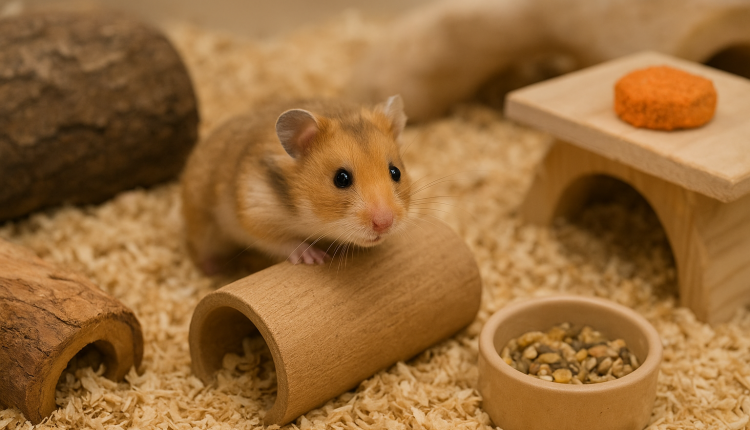Beyond Bedding and Wheels: Enrichment Strategies Every Hamster Owner Overlooks
Hamsters are frequently introduced as “simple pets” — they eat, they sleep, they run on wheels — but in reality, caring for them well demands thoughtful enrichment beyond the basics. If your content has covered nutrition, cages, species differences, or health care, here’s a fresh article idea: what enrichment your hamster truly needs — and what owners almost always forget.
Why Enrichment Matters
Hamsters in the wild spend most of their day digging tunnels, foraging, hoarding, and navigating complex burrow networks. These behaviors occupy both body and mind. In captivity, without sufficient outlets, hamsters can develop boredom, stress, repetitive behaviors, or signs of depression (e.g. fur chewing, lethargy). Enrichment is not a luxury — it’s essential to welfare.
This article will explore enrichment types across domains (physical, cognitive, sensory, social where appropriate), pitfalls to avoid, and creative DIY options.
Four Enrichment Domains You Can Overlook
To comprehensively stimulate a hamster, it’s useful to think in domains. Many owners supply a wheel and a hideout — but forget other dimensions.
1. Spatial & Structural Enrichment
- Layered substrate and burrowing depth: Hamsters should have several inches (ideally 10+ cm) of clean, safe substrate so they can dig and tunnel.
- Tunnels and multi-level pathways: Use solid tubes or custom wooden tunnels (with ventilation) to link areas of the cage, offering exploration routes.
- Climbing features: For dwarf or agile species, smooth ramps, wooden platforms, ladders help simulate a three-dimensional habitat.
- Hidden cavities & hides: Beyond one nest box, include several hide spots. Use ceramic pots, huts, half logs, or inverted boxes so hamsters can choose refuge.
2. Foraging & Food Enrichment
- Scatter feeding: Rather than always supplying food in a bowl, hide bits of pellets or treats in bedding or enclosures so the hamster must dig and search.
- Puzzle feeders: Simple feeders that require manipulation (rolling, sliding, opening) provide cognitive challenge.
- Food in chewables: Stuff small bits of vegetables or pellets into safe chew-wood or cardboard tubes so the hamster works to retrieve them.
- Rotating treat items: Offer occasional novel but safe items — like cleaned dandelion greens or small pieces of cooked sweet potato — to diversify experience (used modestly to avoid digestive upset)
3. Sensory & Novelty Enrichment
- Scent trails & hidden scents: Use non-toxic herbs or mild scents (e.g. dried mint, chamomile) buried under substrate to encourage sniffing/exploration.
- Changing layouts: Every few days, adjust the configuration of tunnels and hides. Even minor changes encourage exploration.
- Textural contrasts: Include surfaces of different textures—smooth wood, natural stones, safe fabric mats—for the hamster to feel with paws.
- Visual “peek” holes: Small windows in tunnels or clear panels (with shade) allow the hamster to see occasional motion, which stimulates alertness.
4. Activity Timing & Variation Enrichment
- Multiple small activity sessions: Rather than letting the hamster run only at night, allocate safe playtime periods (e.g. in a secure playpen) during early evening when they are active.
- Mini challenges: Overnight, place a bit of food just behind a shallow obstacle—so the hamster has to climb a small ramp or push a barrier.
- Intermittent novelty objects: Introduce a new toy, chew stick, or safe object every few days — then remove it — to prevent habituation.
Common Enrichment Mistakes & How to Avoid Them
| Mistake | Problem | Solution |
|---|---|---|
| Overdoing novelty | Too many new items at once overwhelm the hamster | Introduce one change at a time |
| Poor ventilation in tunnels | Lack of airflow causes respiratory issues | Use tubes with air holes or shallow slope |
| Unsafe materials | Glues, small parts, painted surfaces can be toxic | Use untreated wood, ceramic, food-grade materials |
| Uniformity across days | Hamster becomes habituated and bored | Rotate layout and swap objects weekly |
| Neglecting species differences | Some dwarfs dislike heavy climbing; Syrians dislike social roommates | Tailor enrichment to species traits (see § below) |
Tailoring Enrichment by Species & Age
- Syrian (Golden) hamsters: Strictly solitary — social enrichment is harmful. Focus on spatial and foraging enrichment. Provide wheel sized ~25–30 cm to avoid back arching.
- Dwarf (Campbell, Roborovski, Winter White, Chinese): Some may accept same-sex pairs (monitor closely) — but still need plenty of hiding places to avoid conflict.
- Older hamsters: May slow down; reduce challenging objects; avoid steep ramps; ensure tunnels are wide and low.
Young hamsters enjoy exploring novel spaces more, but ensure any enrichment items have no sharp edges or tight grips until they mature.
A Sample Weekly Enrichment Plan
Monday: Rearrange tunnels and hides, bury 1 tbsp of pellets at depth
Tuesday: Place puzzle feeder for evening exploration
Wednesday: Introduce a new chew log with hidden treat inside
Thursday: Change layout again; add scent spot under substrate
Friday: Remove one object, rotate another, allow supervised out-of-cage play in secure area
Saturday: Scatter feed pellets in a cardboard box
Sunday: Strip and deep-clean cage, then return enrichment items in new arrangement
The Impact You’ll See
When you enrich your hamster’s life meaningfully, you should notice:
- Increased exploratory behavior and activity
- Less pacing or repetitive movements
- Happier burrowing/resting patterns
- Better appetite and grooming
- More curiosity toward new safe objects
Observe carefully and always remove anything that seems to provoke fear or aggression.
Final Thoughts
Enrichment is not just an add-on to hamster care—it’s central to their well-being. As you’ve likely covered food, cages, and basic health topics in your site already, focusing on neglected enrichment strategies offers new value. These methods help owners elevate pet life from “surviving” to truly thriving—and readers will treasure the guidance they can apply right away.

